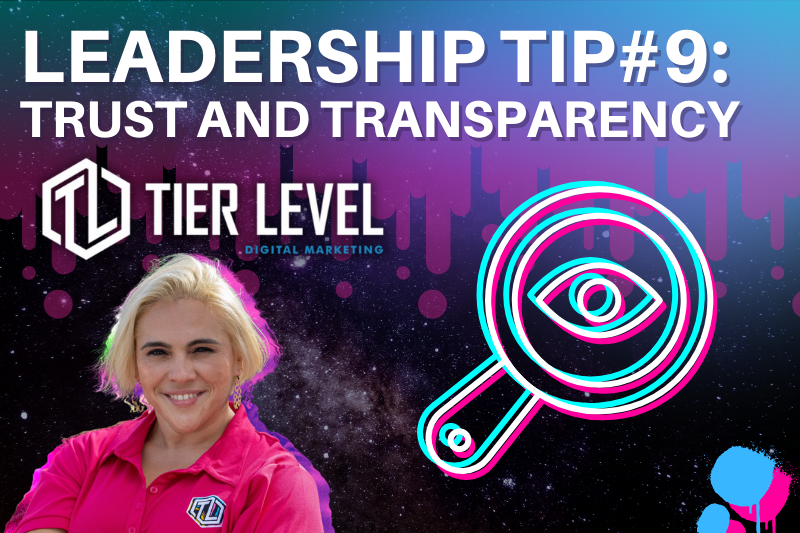Leadership Tips: Trust and Transparency

By Ashlie Marshall, Tier Level Digital Marketing
Trust and transparency go a long way in building strong and long-lasting relationships, both in personal and professional contexts. In the workplace, trust and transparency can create a positive work environment where employees feel valued and motivated to contribute to the organization’s success. In client relations, trust and transparency can lead to loyal clients who are more likely to continue working with the organization.
Before we move on, let’s dive into these two characteristics and unpack them.
- Trust is built over time through a series of actions and interactions. When individuals or organizations are honest, reliable, and consistent, they build trust with others. Trust is the foundation of any successful relationship, and it takes time, effort, and commitment to build. Trust creates a sense of safety, where individuals can be open and honest with each other.
- Transparency involves being open and honest about one’s intentions, actions, and decisions. In a transparent work environment, employees are aware of the organization’s goals, decision-making processes, and the roles and responsibilities of their colleagues. Transparent communication leads to trust in management, and employees feel more comfortable approaching their managers when there are issues, concerns, or ideas. Transparency creates a level of openness and honesty, which fosters trust and builds stronger relationships.
Now that we understand more about these two characteristics, how can they be both helpful and harmful to an organization? What caution should be exercised when implementing and maintaining? These are important questions that must be answered before embarking on the long journey to an open, honest, and transparent work culture.
The positive effects of a transparent workplace that can help to grow the company and build a solid foundation are as follows:
- Building trust: Transparency can build trust between employees and management, as well as between the company and its stakeholders. When employees feel that they have access to information about the company’s operations and decision-making processes, they are more likely to trust the company’s leadership. This can lead to a more positive work environment and a stronger sense of commitment to the company’s goals.
- Encouraging open communication: Transparency can encourage open communication between employees and management, as well as among employees themselves. When employees have access to information about the company’s operations, goals, and decision-making processes, they are more likely to feel comfortable expressing their opinions and ideas. This can lead to more productive discussions and better decision-making.
- Promoting accountability: Transparency can promote accountability by making it clear what employees are responsible for and what is expected of them. When employees know that their actions are being monitored and evaluated, they are more likely to take ownership of their work and be accountable for their actions. This can lead to increased productivity and better decision-making.
Along with all the positive impact transparency can have, there are areas where things can go awry. Here are a few aspects of having a transparent workplace that can be harmful to growth and productivity:
- Breaching confidentiality: Transparency can be harmful when it leads to the disclosure of confidential information, such as sensitive financial or strategic information. This can harm the company’s competitiveness and reputation.
- Creating anxiety and fear: Transparency can also create anxiety and fear among employees, especially if they feel that their performance is being constantly monitored or evaluated. This can lead to a culture of mistrust and competition rather than collaboration.
- Hindering decision-making: In some cases, too much transparency can hinder decision-making by causing delays or creating unnecessary bureaucracy. For example, if every decision needs to be approved by a large group of people, it can slow down the decision-making process and lead to inefficiencies.
It is all about balance and creating solid methods of implementation as well as maintenance that make all the difference for a successful, open, and transparent working environment. Here at Tier Level, we have worked through these, and with a little elbow grease, our leadership team has successfully implemented a strong, trusting, and transparent work culture. Now, to divulge a few of our secrets on healthy applications of transparency. What worked for Tier Level? What are the best parameters in which to operate in order to build a positive culture?
The main focus should be on creating a balance between openness and confidentiality. This can be achieved by establishing clear guidelines for what information can and cannot be shared, as well as by ensuring that employees feel comfortable expressing their opinions and ideas without fear of retribution. Additionally, transparency should be coupled with a culture of trust and collaboration, where employees feel empowered to take ownership of their work and contribute to the company’s success. When these are implemented properly, transparency can strengthen an organization and create a collaborative culture.
Here are a few great tactics for leadership to follow when implementing transparency:
- Be open and honest: Management should be open and honest about the company’s operations, goals, and decision-making processes. This can help build trust among employees and create a more positive work environment.
- Establish clear guidelines: Management should establish clear guidelines for what information can and cannot be shared. This can help ensure that employees feel comfortable sharing their opinions and ideas without fear of retribution.
- Encourage feedback: Management should encourage feedback from employees and be willing to listen to their concerns and suggestions. This can help create a culture of collaboration and open communication.
- Lead by example: Management should lead by example and demonstrate transparency in their own actions and decision-making processes. This can help build trust among employees and promote accountability.
- Provide training: Management can provide training to employees on how to communicate effectively and collaborate with others. This can help create a more collaborative work environment and promote transparency.
Once trust is established, and transparency is adequately implemented internally, a company can then apply similar practices externally to build strong relationships with its clientele. There is significant value in creating an open and honest relationship with the people a company provides services to. Showing vulnerability and human nature in the way they communicate and what they choose to communicate will make a massive impact on client retention. By implementing these strategies, companies can promote transparency and build trust with their clients, fostering long-term relationships and driving business growth.
Tier Level has introduced several strategies that our team of client advisors practices to promote transparency with our clients. Here’s how your company can implement Tier Level’s proven techniques:
- Clear and concise communication: Companies should communicate with their clients in a clear and concise manner, avoiding technical jargon or confusing language. They should be upfront about their processes, pricing, and timelines and provide regular updates on progress.
- Provide complete and accurate information: Companies should provide clients with complete and accurate information about their products or services, including any potential risks or limitations. They should also disclose any conflicts of interest or potential biases that may impact their recommendations or advice.
- Be proactive with disclosures: Companies should disclose any changes to their products or services, including updates to terms and conditions, pricing, or delivery timelines, in a timely and transparent manner. This helps clients make informed decisions and avoids any surprises.
- Use technology to enhance transparency: Companies can use technology to provide clients with real-time updates on their projects, deliveries, or service status. This can include online portals, mobile apps, or SMS notifications, giving clients full visibility into their account and project status.
- Solicit feedback: Companies should actively solicit feedback from their clients, providing opportunities for them to share their experiences and provide suggestions for improvement. This feedback can be used to improve products or services and build stronger relationships with clients.
Overall, transparency and trust are essential components of building strong and retained relationships with customers. Through clear, concise, and completely open communication, Tier Level has built long-lasting relationships with our clientele. We have used the newest technology as it continues to advance, and we are constantly asking for feedback from our customers to improve not only our service but our relationships with them as well. We are proud of our company internally and externally, and we work hard every day to continue to foster strong relationships within our team and, in turn, with our clients.
So, what is the main takeaway from all of these strategies on trust and transparency for companies internally and externally?
First of all, IT WORKS!
Secondly, these strategies for companies, both internally and externally, communicate that building and maintaining trust is essential for a successful and sustainable business. Trust is built through open and honest communication, clear and consistent messaging, and a commitment to delivering on promises.
Internally, trust and transparency are important for building a positive company culture and fostering employee engagement. When employees feel that they are part of a transparent and trustworthy organization, they are more likely to be productive, innovative, and committed to the company’s success.
Externally, trust and transparency are essential for building strong relationships with customers. When companies are transparent about their processes, products, and pricing, they build trust and credibility with their customers. This, in turn, leads to increased customer loyalty, positive word-of-mouth recommendations, and improved brand reputation.
Ultimately, companies that prioritize trust and transparency both internally and externally, like us here at Tier Level, are more likely to succeed in the long term. By implementing the above strategies internally and fostering a culture of trust and transparency, companies can create safe and positive work environments, promote open and honest communication, and foster a sense of reliability and commitment. By practicing trust and transparency externally, individuals and organizations can build strong relationships, attract loyal clients, and position themselves for long-term growth and success.












